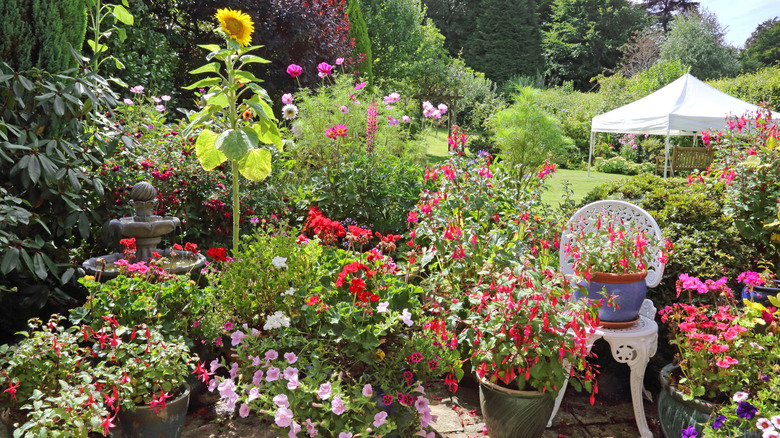Growing This Pretty Perennial Flower Comes With A Surprisingly Tasty Perk
Fuchsias (Fuchsia) might win you over with their looks, but these perennial flowers have more going on than meets the eye. While many flowers only put on a show for passersby, fuchsias also please the garden's visiting wildlife and your taste buds. With their easygoing nature, they're a low-maintenance perennial that'll thrive in shady areas where other plants won't — a true standout in any garden.
Endlessly lovable, fuchsias come in more than 100 species, stretching across the warmer Americas and all the way to New Zealand. Their berries vary just as much: some are delicious little treats, others pack a nutrient- and medicinal-rich punch, and a few are best left alone for good reason. Be sure to check the care information for specific varieties to ensure they're edible before adding the berries or flowers to your next dish.
The berries are a tad tart with a lemony zing, and some even liken them to stoneless cherries. Snack on them straight from the garden, toss them into a salad, make jam, or blend them into your favorite drinks; they're as flexible as they are flavorful. Don't forget the flowers. Their delicate petals add a pop of color to salads, and if you're a fan of iced drinks, you can freeze them in ice cubes for a playful touch. Flowers are easiest to harvest when fully open, and since the plant keeps flowering while fruiting, you can enjoy both berries and blooms at the same time. A true win-win.
How to grow and enjoy fuchsias in your garden
Unlike many perennials that love basking in the sun, fuchsias thrive in partial or even full shade, though a little morning sun won't put them in a bad mood. Hardiness depends on the species and cultivar: some can tough it out in Zones 6 or 7, while others only feel at home in Zones 9 or 10. In general, they prefer cooler conditions and don't handle frost or extreme heat well. Soil-wise, aim for slightly acidic to neutral (pH 6.0 to 7.0) with good drainage. Their roots hate sitting in overly wet soil, which can lead to rot, fungus, or bacterial issues. Keep things evenly moist, but never drenched.
Fuchsias aren't divas, but they do appreciate a little TLC to keep the blooms coming. Keep them consistently watered, especially in summer, giving the plants a deep soak without drowning the roots. Feed the flowers with a balanced fertilizer every couple of weeks during the growing season as they are heavy feeders, and don't be shy about pinching back the tips — it encourages branching and more flowers. Since they're tender to frost, they're one of those plants that should be moved indoors before the first freeze, where they'll be perfectly happy riding out winter in a cool, bright spot.
Fuchsias don't just charm gardeners. The shade plant's nectar-rich blooms attract hummingbirds and bees to your yard, while their edible flowers and berries are a tasty perk. This striking perennial is more than just a pretty face; it's a true garden multitasker with plenty to offer.

